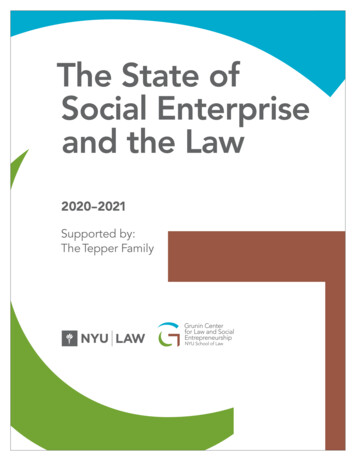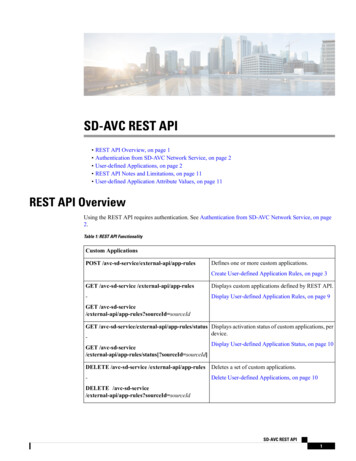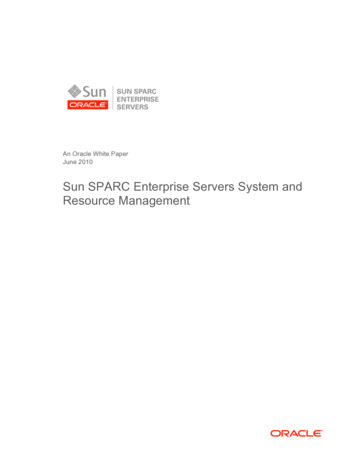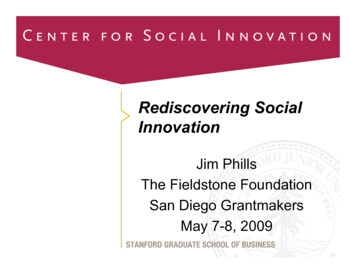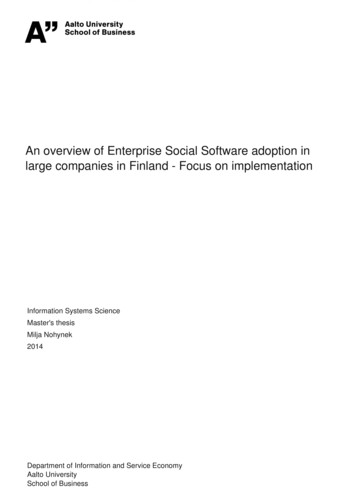
Transcription
An overview of Enterprise Social Software adoption inlarge companies in Finland - Focus on implementationInformation Systems ScienceMaster's thesisMilja Nohynek2014Department of Information and Service EconomyAalto UniversitySchool of BusinessPowered by TCPDF (www.tcpdf.org)
AALTO UNIVERSITY SCHOOL OF BUSINESSABSTRACTDepartment of Information and Service Economy06.09.2014Master’s ThesisMilja NohynekABSTRACTObjectives of the StudyGlobally, the Enterprise Social phenomenon is gaining footage in organizations, transformingthem more transparent, communicative and collaborative. In Finland the Enterprise SocialSoftware (ESS) tools behind this transformation are not yet that common, and many companiesare currently working on the selection and implementation of these tools. At the same time theESS implementations in other countries have often failed due to lack of proper implementationefforts. The objectives of this study are two-fold: to form an understanding on the state of ESS inlarge companies in Finland, and to present a framework on how to best implement these toolswithin this target group. The intentions on a larger scale are to encourage companies to start thejourney to Enterprise Social, and to provide tools and knowledge of ESS implementations overall.Academic background and methodologyThe academic base on the research is founded on Enterprise Social literature, which has gainedpopularity recently. The terminology and Enterprise Social background are covered first morebroadly to form an understanding on the Enterprise Social field. The main part of the research isbased on a literature review on ESS and the best practices for their implementation, synthesizingthe results as a preliminary implementation framework. The empirical part consists of 18interviews and an online survey, and is aimed at comparing the findings from the literaturereview against the interview insights. A revised framework is developed from the results.Findings and conclusionsThe findings of this thesis are two-fold; the state of ESS in large companies Finland and the bestpractices for its implementation. The ESS tools are now at implementation or recentlyimplemented level in many large companies, but the process overall is still at the very beginningconcerning the cultural change it requires. As a main derivative, the implementation frameworkand the necessary steps were formed, combining the results from both the empirical research andthe literature review. The key success factors of ESS implementation were identified. The resultsregarding implementation best practices emphasize the importance of concrete managementsupport, real business cases for the tools, and community manager’s as well as productchampions’ efforts in the implementation process.KeywordsEnterprise Social Software, Enterprise 2.0, Enterprise Social, implementation, end-user adoption
AALTO-YLIOPISTON KAUPPAKORKEAKOULUTIIVISTELMÄTieto- ja palvelutalouden laitos06.09.2014Pro Gradu-tutkielmaMilja NohynekABSTRAKTITutkimuksen tavoitteetMaailmalla yritysten sosiaaliset teknologiat (Enterprise Social Software) ovat yleistyneet,muovaten organisaatioita läpinäkyvämpään, viestinnällisempään ja yhteisöllisempään suuntaan.Suomessa nämä sosiaaliset työkalut ovat vasta ottamassa jalansijaa, ja monet organisaatiotovatkin juuri aloittamassa työkalujen jalkautuksen. Samalla kansainväliset tutkimukset osoittavat,että ehdottomasti suurin osa näistä käyttöönotoista epäonnistuu, johtuen liian vähäisestäpanostuksesta jalkautukseen. Näistä syistä tämän tutkimuksen tavoitteena on tuottaa sekäyleiskuva Enterprise Social –työkalujen käyttöönotoista suurissa yrityksissä Suomessa, ettäerityisesti tehdä malli näiden työkalujen jalkautukseen tässä kohderyhmässä. Yleisemmällätasolla pyrkimyksenä on kannustaa suomalaisia yrityksiä ottamaan sosiaalisia työkaluja käyttöön.Kirjallisuuskatsaus ja metodologiaTutkimuksen akateeminen pohja perustuu vahvasti Enterprise Social –kirjallisuudelle, joka onaivan viime vuosina yleistynyt. Terminologia ja taustat Enterprise Social –tutkimuksen ympärilläkartoitetaan kirjallisuuskatsauksella. Pääosa kirjallisuuskatsauksesta keskittyy Enterprise Social–työkalujen jalkautusmallien vertailuun, ja alustavan jalkautusmallin luomiseen. Tutkimuksenempiirinen osuus koostuu 18 haastattelusta sekä verkkokyselystä, ja se tähtää alustavanjalkautusmallin tuloksien verifiointiin. Lopullinen jalkautusmalli luodaan empiiristen tulostenpohjalta.Tulokset ja päätelmätTutkimuksen tulokset valottavat Enterprise Social –työkalujen tilaa suurissa yrityksissäSuomessa, sekä parhaita käytäntöjä niiden jalkauttamiseen. Suomalaisissa yrityksissä EnterpriseSocial –työkalut ovat pääasiassa jalkautusprosessin alkuvaiheessa, etenkin niiden vaatimaankulttuurimuutokseen liittyen. Tutkimuksen päätuotoksena on Enterprise Social –jalkautusmalli,joka painottaa keskeisimpiä vaiheita ja tekijöitä jalkautuksessa. Lisäksi tärkeimmät jalkautuksenonnistumisen tekijät tunnistetaan: näihin tekijöihin kuuluvat johdon ja muiden sidosryhmienkonkreettinen tuki, työkalujen linkittäminen päivittäiseen työhön, sekä yhteisömanagerin ettäpääkäyttäjien vahva osallistuminen ja sitoutuminen jalkauttamisessa.AvainsanatEnterprise �ineniiviestintä,intranet,jalkautusmalli,
ACKNOWLEDGEMENTSI want to thank especially my instructor Johanna Bragge, who has been a great guide and supportwith this journey to Enterprise Social. I am also very grateful for all the feedback and help I havereceived from Petri Säkkinen and the whole personnel of Digital Illustrated.Additionally, I want to thank all the interviewees, who kindly shared their insights to thisresearch.iii
TABLE OF erpriseSocialSoftware.14iv
HODOLOGY.283.1.Thepre- Full- efull- inesscase.53v
S.65REFERENCES.69APPENDICES.76vi
LIST OF FIGURESFigure 1: Magic Quadrant of Social Software in the WorkplaceFigure 2: The amount of ESS in companiesFigure 3: The popularity of different ESSFigure 4: The popularity of different ESS functionsFigure 5: The ESS usage in survey companiesLIST OF TABLESTable 1: Most common Enterprise Social featuresTable 2: The initial action steps for ESS implementation according to the reference literaturevii
1. INTRODUCTIONWe are now living a major change in enterprise communication and collaboration - a similarchange to what was experienced when email was brought to workplaces in the 1980’s. Thetransformation is about Enterprise Social, or Enterprise 2.0, which means the use of social andnetworking tools for collaborating on the intra-organizational as well as inter-organizationallevel (Consoli, 2013). These tools and methods transform the interaction of workers fromprevailing one-to-one communication into many-to-many, and the information and knowledgebecomes accessible, transparent and searchable instead of being locked down in email folders.The social technologies have changed rapidly and radically the way we live, and this change isnow reaching the enterprise side. These tools are called Enterprise Social Software (ESS), andthey facilitate the creation of web content, as well as communication and interaction with otherpeople via e.g. microblogging and social networking sites on a corporate setting (Richter et al.2012). The potential of ESS is tempting, as it is estimated to raise the productivity of interactionworkers by 20-25% if the enterprise adopts the networking ways of working (Chui et al., 2012).However, this requires substantial change in not only the IT landscape, but in fact more inprocesses, practices and culture of the organization. The Enterprise Social revolution is not abouttechnology, but change in the way of working.As social technologies are familiar to people on the private life side, most companies that haveadopted Enterprise Social have not emphasized the implementation, which has led to failures inadopting the tool (Gartner, 2013). This is mostly due to the perceived ease of use of the tools aswell as non-business-criticality of the platform. It tells about the need for proper implementationregarding these tools as well as managerial understanding on the change in company culture andprocesses it requires.This research will focus on the adoption of ESS inside the enterprises, analyzing the bestpractices of the implementation process of these tools. In order to provide a set of practices, anoverview on the current Enterprise Social landscape is formed. The approach of this thesis stays1
general product-wise, since the ESS adoption, as stated above, is merely about change inorganizational culture and processes than a technical integration.1.1. Motivation and goals for studying ESS implementation inFinland“The term social software refers to web-based applications which support human interaction aswell as the networking of the users” (Steinhüser et al., 2011). The meaning is still evolvingregarding the enterprise setting, but basically Enterprise Social should change the way we workin all functions, with all stakeholders. The old, hierarchical way of communicating will hopefullypass, and the transparent and interactive working methods take their place. There are two majordevelopments that have reduced the efficiency of divided, silo-based organizations: the increasedpower and knowledge of customers and the importance of knowledge (Gulati, 2007).However, the majority of larger companies still have very hierarchical approaches to the flow ofinformation, as they are divided into functions, organizations and geographical locations. Thetop-down approach can make it difficult to let information pass among employees and enhancecollaboration overall (Tsai, 2001). Although the new ways of Enterprise Social are available, thetools are still not widely adopted. The topic caught my eye in Autumn 2013, when the Gartnerreport on Enterprise Social was published (Gartner, 2013), stating that there is still a long wayfor the maturity on the Enterprise Social field.Already McAfee (2009) spoke out the fears of the implementation of these tools. He had noticedthat concerns around Enterprise 2.0 fall into two broad categories: fears that people will not usethe newly available software, and fears that they will. When conducting the preliminaryinterviews to iterate on the topic of the thesis, I noticed that in many Finnish companiesEnterprise Social was still very feared or unknown possibility. This is why the first goal of thisstudy is to take an overview on the field – to offer a broad outlook for these companies on theEnterprise Social, and how it is used in Finnish companies. This way I hope to enlighten thetopic as well as reduce the ambiguity on the field – and to offer organizations more courage totake the step towards Enterprise Social.2
Personally, I have worked with intranets and Enterprise Social solutions in many companies. Ihave therefore had the opportunity to see very close how the internal communication methodsare implemented in different organizations. Additionally, the Gartner research revealed that asmuch as 90% of these Enterprise Social implementations fail (Gartner, 2013). This is the primaryreason I especially wanted to focus on the implementation topic; to gather best practices and thencompare them to the real life experiences from Finnish companies. My other goal is hence todevelop a coherent implementation framework that can serve the companies that are startingtheir journey towards a more social enterprise.1.2. Development of the research questionWhen considering Enterprise Social Software, or any IT solution, the bottom line of its successderives from whether it is used or not. This is why the implementation plays such an essentialrole in any new IT tool’s launch. According to Muller et al. (2012), enterprises offer a differentcontext for interaction at social software tools than the consumer side does, and hence theorganizations cannot just assume that the tools are easily adopted even if they are alike. Thereports show that Enterprise Social is very often implemented exactly like this; the tools are justtaken into action with no formal implementation – and with very poor results (Gartner, 2013).The tools are seemingly easy to use, but the real adoption actually requires a lot of work and time,which comes as a surprise for many companies. This is one main motivator for this study: topresent a coherent view on these tools’ usage currently, and what are the best practices for theirimplementation.The variables that affect the Enterprise Social adoption are various. Many studies have identified“uncertainty avoidance” or “perceived usefulness” as influential variable in predicting Web 2.0usage (Ribière et al., 2010; Saldanha and Krishnan, 2010). The references on cultural differencesaffecting the Web 2.0 implementation within organizations are still limited, as there are multipleother factors, for example organization size and culture that equally affect the adoption (VonKrogh, 2012). However, there are some initial linkages between national culture and IT adoption(Hofstede, 2001). The focus of this research is on Finland as a national context, to exclude thepossibilities of national culture factors affecting the research.3
When it comes to the other confining factors, the focus is merely on large companies, as theprobability of the ESS use increases by the size of the organization (Fuchs-Kittowaki et al.,2009). Small and large companies have quite distinct characteristics, and are fundamentallydifferent in a number of ways (Lee and Xia, 2006; Gudanov et. al., 2010). Most researcheshypothesize that large organizations adopt IT more rapidly than small organizations, and thereare findings that large organizations benefit more from these tools due to network effects(Saldanha and Krishnan, 2010). A broad view of different kinds of large organizations isprovided in this study in order to get a comprehensive overview on the field. Additionally, thefocus of this research is on the internal adoption of Enterprise Social, not considering the ESSadoption and success with external networks, in order to provide a clear focus for the study.Accumulating from these statements, my research has two objectives:1.To provide a coherent view on the state of Enterprise Social usage in largecompanies in Finland2.To form a concise implementation framework for Enterprise SocialSoftware for large companies in Finland1.3. Earlier research and the research gapThe topic Enterprise Social, or Enterprise 2.0 is relatively new, but there is already an ampleresearch base on that topic. The term Enterprise 2.0 has seen its daylight in 2006 by its inventorAndrew McAfee (2009), and up until today it has been a very discussed topic in the businessworld, but also academic references are increasingly found. Enterprise 2.0 has many similarterms around it, like Collaboration 2.0, Enterprise Social, Enterprise Social Media, and so on.The lines between these terms are still quite blurry, which indicates the newness of theterminology.Also, a few implementation frameworks relating to Enterprise 2.0 adoption have been presentedin the literature (e.g. McAfee, 2009; Janes et al. 2014; Louw & Mtsweni, 2013; Nedbal et al.2013; Baxter & Connolly, 2014; Chui et al. 2009), but they offer only general frameworks for4
implementation. Hence, there are no specific frameworks for large organizations, which is thefocus in this study. As Van Krogh (2012) states in his comparative study, there has not beenenough academic research on the adoption enablers of social software overall, and hence thisstudy adds to this research area. Additionally, no extensive research on the adoption andimplementation of Enterprise Social in Finland has been conducted. Therefore, this gap in earlierresearch is filled, in order to offer an overview on the segment of large companies in Finland,and their experiences on the implementation of ESS.1.4. Methodology of the researchThe research is based on three methods: literature review, interviews and a survey. The literaturestudy forms a basis on the entire landscape of Enterprise Social and its implementationapproaches, and aims at forming a preliminary framework for ESS implementation based oncurrent findings from the field. The interviews provide a comparative view on the initialframework based on the reality of the large enterprises in Finland. The interviewees wererecruited from 18 large Finnish organizations: all of the interviewed companies are in Finland’stop 100 companies, and as much as one third belong to top 10. The survey, on the other hand, istargeted to confirm the interview results, and was sent to 100 large companies in Finland. Thesethree data layers form a basis on which the results are founded: the initial implementationframework is calibrated regarding the findings of the interviews and survey, and a revisedframework is developed. This framework will present a concise view on best implementationpractices in the Enterprise Social field for large companies in Finland.1.5. Structure of the researchThe research starts with a literature review that discusses the Enterprise Social in general as wellas ESS implementation approaches, finishing by forming an initial framework of the ESSimplementation in Chapter 2. Next, the methodology of the research is outlined in Chapter 3.Thirdly, the insights of the interviews and survey are divided into two parts; the first part outlinesand discusses the state of Enterprise Social in Finland in Chapter 4.1, and the second partdiscusses the implementation practices of the interviewed companies in Chapter 4.2, mapping the5
results to the initial framework. Finally, the results are put together and discussed in the Chapter5. The thesis is concluded by a discussion in Chapter 6, and summary and conclusions in Chapter7.6
2. LITERATURE REVIEWThis literature review provides a thorough picture on Enterprise Social and its implementationpractices. First, a brief introduction of the background of the term and the different terminologyaround it is presented. The second part is devoted to the literature review on Enterprise Socialimplementation practices, which is followed by the creation of the initial implementationframework that will be used later on in this research.2.1. Background of Enterprise SocialIT and collaborative work practices have a long history together, which is reflected also in theresearch literature. Collaborative information systems have been actively researched especiallyin the fields of Information Systems Science (ISS) and Human-Computer Interaction (HCI orCHI). The researchers in ISS have studied computer-mediated collaboration under the topicnames Group (Decision) Support Systems G(D)SS or Electronic Meeting Systems (EMS)already from the mid 1980’s. According to de Vreede et al. (2014) this GSS research area has thelargest body of publications in the collaboration area, especially during the late 1980’s to the late1990’s (see also Bragge et al. 2007 for a bibliometric review of 2.000 articles on G(D)SS andEMS research). HCI researchers have studied the topic under the term Computer-SupportedCollaborative Work (CSCW), and the first CSCW workshop was held already in 1984 (Schmidtand Bannon, 2013). A vast array of different GSS and CSCW solutions has since been developedby software vendors over the years to make collaborative work better (McAfee, 2009).According to McAfee (2009), for CSCW there were two main applications in the 1980’s and1990’s: groupware and knowledge management (KM). Groupware was aimed for employees towork better together, giving them access to shared information and communication tools - anexample of this was the Lotus Notes tool. Organizations used these tools mainly for messagingand calendar functions, but found that these software were less prominent with finding andsharing information. Knowledge management, on the other hand, meant databases, where thehuman knowledge, expertise and insights were to be collected.7
From the early 21st century onwards the rapid growth of the Internet and ICT sector markedmany changes in the tools that enabled Collaboration 1.0. The web tools became Web 2.0,collaboration became Collaboration 2.0 and the term Enterprise Social, or Enterprise 2.0 wasinvented (Turban et al. 2011; McAfee, 2009). Today, times have changed dramatically from theCSCW and GSS applications, as nowadays ICT has become the glue that ties employees, tasks,organizations and countries together. It has become the foundation of all sectors and economies,since it channels knowledge, reduces transaction costs, and provides easy access andconnectivity, among numerous other benefits (Kramer et al., 2007). Knowledge management isequally changing rapidly: from centrally managed, structured and controlled access to knowledge,today the knowledge management is conducted incrementally via social software. These newcloud-based solutions are effective, less costly and mobile, and they support group interactiontowards communities and content creation (Von Krogh, 2012).Social software is today perceived to fundamentally disrupt the way employees handleknowledge (Bebensee et al., 2011). According to Leftheriotis and Chiannakos (2014) there isevidence that not only the Enterprise Social disrupts the old ways of working, but alsosignificantly and positively impacts the employee performance. Bebensee et al. (2011) state thatthe social tools in question are founded on three layers. At first, the tools are founded on socialprinciples and collaboration. Secondly, the tools consist of many applications, like wikis, blogs,social bookmarking, and other intuitive easy-to-use services. Thirdly, their infrastructure is basedon open platforms and services that can bring economies of scale. (Ibid.).Despite the potential of all these new features and applications, the social software adoption isstill today quite far from the ideal of effective collaborative work, where people both create andshare information as a community. Although the tools and terminology have evolved from theCSCW times to Enterprise 2.0 (McAfee, 2009), people are still very much stuck on producinginformation on one-to-one or one-to-many tools, like email and instant messaging (Chui et al.2012). The Enterprise Social literature (e.g. Bebensee et al., 2011; McAfee, 2009; Richter et al.,2012; Leonardi et al., 2013) concludes that these t
Figure 1: Magic Quadrant of Social Software in the Workplace Figure 2: The amount of ESS in companies Figure 3: The popularity of different ESS Figure 4: The popularity of different ESS functions Figure 5: The ESS usage in survey companies . LIST OF TABLES . Table 1: Most common Enterprise Social features



